HAL Id: hal-03066487
https://hal.univ-grenoble-alpes.fr/hal-03066487
Submitted on 15 Dec 2020
HAL is a multi-disciplinary open access
archive for the deposit and dissemination of
sci-entific research documents, whether they are
pub-lished or not. The documents may come from
teaching and research institutions in France or
abroad, or from public or private research centers.
L’archive ouverte pluridisciplinaire HAL, est
destinée au dépôt et à la diffusion de documents
scientifiques de niveau recherche, publiés ou non,
émanant des établissements d’enseignement et de
recherche français ou étrangers, des laboratoires
publics ou privés.
Effect of claystone small-scale characteristics on the
variability of micromechanical response and on
microcracking modelling
Benoît Pardoen, Pierre Bésuelle, Stefano Dal Pont, Philippe Cosenza, Jacques
Desrues
To cite this version:
Benoît Pardoen, Pierre Bésuelle, Stefano Dal Pont, Philippe Cosenza, Jacques Desrues. Effect of
claystone small-scale characteristics on the variability of micromechanical response and on
microcrack-ing modellmicrocrack-ing. 16th International Conference of IACMAG - International Association for Computer
Methods and Advances in Geomechanics, May 2021, Turino, Italy. �10.1007/978-3-030-64514-4_52�.
�hal-03066487�
Effect of claystone small-scale characteristics on
the variability of micromechanical response and
on microcracking modelling
Benoît Pardoen1,*, Pierre Bésuelle2, Stefano Dal Pont2, Philippe Cosenza3, and
Jacques Desrues2
1 Laboratoire de Tribologie et Dynamique des Systèmes (LTDS), Ecole Nationale des Travaux
Publics de l’Etat (ENTPE), 69120 Vaulx-en-Velin, France
*benoit.pardoen@entpe.fr
2 Univ. Grenoble Alpes, CNRS, Grenoble INP, 3SR, 38000 Grenoble, France 3 Institut de Chimie des Milieux et Matériaux de Poitiers (IC2MP), Université de Poitiers, 86000
Poitiers, France
Abstract Argillaceous rocks have a complex and heterogeneous structure at different scales. At the scale of the mineral inclusions embedded in a clay matrix, the deformation generally induces microcracking and material damage. Modelling the latter requires to take into account mi-croscale characteristics and their effect on the micromechanical response. This response can be used in double scale approach to predict material behaviour at larger scale. Thus, heterogeneous microstructures of a claystone are generated with a distribution of morphological properties sat-isfying experimental observations. The overall microscale material behaviour under solicitation is obtained by numerical homogenisation. Then, the variability of the material response is stud-ied with regard to small-scale characteristics. In terms of deformation and failure, a dominant shear deformation mode and decohesion between grains are observed. The decohesion induces microcracking in the microstructure and strain softening of its overall response.
Keywords: Modelling, Clay rock, Micromechanics, Homogenised response, Microcracking.
1 Introduction
Clayey rocks are considered as host rocks for deep geological repository of nuclear wastes. The role of material microstructure on the mechanical behaviour at macro-scopic scale is a crucial issue. Clay rocks have a complex heterogeneous structure over a wide range of scales. For deformation, mechanical damage, and macroscopic failure, the most relevant scale is the one of the mineral inclusions and microcracking, i.e. the micrometric scale (Desbois et al., 2017). In the following, the material behaviour and its characteristics are considered at this scale. The mineralogical properties include grain morphology and mineral phase proportions. Defining realistic microstructure al-lows to derive the overall microscale behaviour by computational homogenisation. The material behaviour variability is then analysed regarding microstructure
variabil-2
ity, microstructure size, and grain morphology. Hereafter, the studied clay rock and its microstructure are firstly described. Secondly, the generation of representative numer-ical microstructures is built from realistic characteristics obtained based on experi-mental characterisation. Thirdly, the used microscale model is briefly presented. Last-ly, the clay rock behaviour is modelled leading to the reproduction of mechanical response, deformation, micro-damage, and microcracking that depend entirely on the microstructure. The behaviour variability is also investigated with regard to microscale properties.
2 Clay rock microstructure
The considered material is the Callovo-Oxfordian claystone (COx) studied by the ANDRA in France for nuclear wastes repository. The COx claystone is a cross-anisotropic, low-permeable, and indurated shale with quasi-horizontal bedding planes. The mineralogical characteristics and the generation of representative microstructures are detailed in this section.
At microscale, the structure of the COx claystone is heterogeneous due to the presence of several mineral types. In the following, the considered small scale is the one of the mineral inclusions and experimental evidences (Yven et al., 2007; Robinet et al., 2012; Cosenza et al., 2015; Armand et al., 2017) are used to represent the claystone micro-structure in a realistic manner. The zone of interest is the COx clay-rich unit (located at 490m depth). It is a zone composed of a high clay mineral content in the form of a porous clay matrix which embedded non-porous mineral inclusions (Robinet et al., 2012). Its main mineralogical characteristics are detailed hereunder with average val-ues summarised in Table 1. These valval-ues are derived from 2D vertical material sec-tions (SEM and X-ray micro-CT) perpendicular to the bedding planes (Robinet et al. 2012).
- Mineralogical composition: Tectosilicates (mostly quartz) 15-25%, car-bonates (mostly calcite) 25-35%, heavy minerals (pyrite) 0-3% and clay min-erals 40-60% (Armand et al., 2017).
- Size of mineral inclusions: It ranges from several to a few hundreds of mi-crometers (Robinet et al., 2012). Quartz grains are larger than carbonates, in average, and pyrite grains are the smallest.
- Morphology of mineral inclusions: In average, carbonate inclusions are more elongated than quartz (2D elongation =1 if round, <<1 if elongated in Table 1 and Fig. 1c). The average preferential orientation is horizontal (0°, Fig. 1d) and thus parallel to the bedding planes.
- Characteristic size: For morphological characteristics, the size and length of a Representative Elementary Volume (REV) are VREV≈0.001mm³ and
Furthermore, deformation and cracking mechanisms occur at microscale. Potential decohesion mechanisms around mineral inclusions and microcracking within the clay matrix develop in the claystone (Desbois et al., 2017; Bésuelle et al., 2019). Contacts between clay matrix and non-clay inclusions serve as microcrack attractors. Then, in-tergranular microcracking paths develop through the clay matrix (Desbois et al., 2017).
Table 1 Average mineralogical characteristics of the COx claystone (EST26095)
Minerals Orientation Elongation [-] Mean area [μm²] Area fraction [%] Clay matrix - - - 50 Pyrite - - - 2 Calcite horiz. 0.55 45 30
Quartz horiz. (variable) 0.64 100 18 From the above mineralogical characteristics, it is possible to generate realistic micro-structures. 2D microscale elementary areas (EA) are developed to represent the grains and the failure modes at small scale. Heterogeneous microstructures are generated with periodic random Voronoï tessellation. It allows to define the solid grains, each cell representing an inclusion or a clay grain (see Fig. 1a). The generation method is adapted from van den Eijnden et al. (2017) to enrich the mineralogical characteristics (Pardoen et al., 2020). A variability of the latter is also considered to reproduce the ob-served distribution of clay and mineral contents, orientation, and elongation. Examples of realistic microstructures of COx claystone are visible in Fig. 1a and Fig. 3a.
Fig. 1 Representativeness of the microstructures: (a) example of numerical elementary area, (b) dis-tributions of clay content, (c,d) comparison of experimental and numerical morphological characteris-tics of calcite (Robinet 2008)
4
As aforementioned, the considered elementary areas are representative of vertical sec-tions perpendicular to the bedding planes. They are numerically dimensionless; how-ever, an artificial characteristic size of LEA=100μm (corresponding to experimental
measurements) is assign by choosing the number of grains represented (250 Voronoï cells). The microstructure representativeness and variability are assessed by comparing experimental and numerical morphological characteristics of minerals. The compari-son in Fig. 1 is realised on a set of 100 numerical EAs. It highlights the accurate re-production of clay contents and morphology of inclusions. This rere-production of mor-phological characteristics together with the consideration of deformation and cracking mechanisms in section 3 lead to a realistic definition of the material microstructure.
3 Microscale model
The microscale model contains the details of the material microstructure and is em-bedded in a double-scale finite element (FE²) approach (Frey et al., 2013; van den Eijnden et al., 2016, 2017). The overall response of periodic microscopic EA is de-rived by microscale finite element computation and then used as a homogenised im-plicit constitutive model at macroscale (by computational homogenisation). The scale transition is realised by enforcing periodic boundary conditions on the 2D microscale model (under plane strain conditions) which result of the macrostrain. Hereafter, the focus is on the microscale model definition and its ability to reproduce the behaviour of clay rock, including the deformation processes at grain scale.
The generated EAs (Fig. 1a) are defined as assemblies of (isotropic linear) elastic de-formable continuous solid grains in interaction with cohesive crack models. The latter are damageable cohesive interfaces which permit material softening due to defor-mation. Thus, the non-linearity of the material behaviour is concentrated at grain con-tacts. The cohesive laws in both tangential and normal contact directions are given by:
𝑐𝑡= 1 𝐷𝑡 (1 − 𝐷𝑡) 𝛥𝑢𝑡 𝛿𝑡𝑐 𝑐𝑡𝑚𝑎𝑥 (1) 𝑐𝑛= 1 𝐷𝑛 (1 − 𝐷𝑛) 𝛥𝑢𝑛 𝛿𝑛𝑐 𝑐𝑛𝑚𝑎𝑥− 𝜅 𝛥𝑢𝑛2 (2)
where t and n subscripts correspond to tangential and normal directions, cn/t are
inter-face cohesion forces, 𝑐𝑛/𝑡𝑚𝑎𝑥 are maximal cohesion forces, Δun/t are interface relative
displacements. Then, Dn/t are softening parameters representing the interface
degrada-tion state 0≤Dn/t≤1 (depending on initial degradation states 𝐷𝑛/𝑡0 and time history of
Δun/t), 𝛿𝑛/𝑡𝑐 are critical relative displacements inducing complete decohesion (Dn/t=1,
cn/t=0), and κ is a penalisation term to avoid grain interpenetration (κ >>𝑐𝑛𝑚𝑎𝑥 if Δun<0,
Following the above definitions, large deformations may develop at microscale and are mainly concentrated at grain contacts. Potential microcracks are considered at grain interfaces which allows two failure types as observed in the clay rock (Desbois et al., 2017; Bésuelle et al., 2019): decohesion around inclusions (inclusion-clay con-tacts) and intergranular microcracking within the clay matrix (clay-clay concon-tacts). Grain breakage is not considered. However, numerous possible microcrack paths can develop within the clay matrix. Furthermore, only crack porosity is considered at grain interfaces.
4 Modelling of clay rock behaviour
The micromechanical properties of the heterogeneous EAs are chosen to reproduce the clay rock behaviour (Table 2). Each mineral constituent is assigned linear elastic prop-erties (Ahrens, 1995; Robinet et al., 2012; van den Eijnden et al., 2017) and homoge-neous interface properties are assumed (van den Eijnden et al., 2017; Pardoen et al., 2020). The clay rock micromechanical behaviour is analysed through the responses of EAs subjected to loading. A biaxial compression is numerically modelled in 2D plane strain state with a first isotropic confining phase followed by a vertical compression (enforced global homogenised vertical strain ε1) under constant lateral confining
pres-sure σ3. The variability of material response and deformation processes under
devia-toric solicitation are analysed. Stress-strain deviadevia-toric response curves are detailed in Fig. 2 for σ3=12MPa. They present the evolution of the global deviatoric stress q=σ1
-σ3 with the homogenised vertical ε1 and lateral ε3 strains of the EAs. Numerical results
indicate that the microscale overall response shows some dispersion due to the varia-bility of the microstructures (i.e. variable inclusion positions, mineral contents, and grain morphology).
Table 2 Microscale mechanical parameters
Minerals ν [-] E [GPa] Clay ma-trix 0.110 2.3 Pyrite 0.154 305 Calcite 0.317 84 Quartz 0.074 95 Interfaces 𝑐𝑛𝑚𝑎𝑥 [𝑀𝑃𝑎] 𝑐𝑡𝑚𝑎𝑥 [𝑀𝑃𝑎] 𝐷𝑛/𝑡0 [−] 𝛿𝑛/𝑡𝑐 [−] 1.0 2.5 0.001 0.1
The results in Fig. 2a highlight the response scattering related to the randomness of in-clusion positions, morphology, and mineral contents (random EA generation). In Fig. 2b, the mineral contents are fixed with 50% of clay and only the range and the average response curves are detailed. The highlighted variability suggests that the chosen EA size, based on grain morphology, is not sufficient regarding the mechanical response.
6
The effect of microstructure size is studied for different number of cells in the EAs. 50, 100, and 250 cells lead to mean characteristic lengths of LEA = 50, 70, and 105 μm
(Fig. 3a). The other micromechanical parameters are kept from Tables 1-2, with 50% of clay. For each case, the range of response curves (over 10 EAs) is illustrated in Fig. 3b. The variability of the microscale response reduces with increasing size, which mit-igates the partial lack of EA representativeness. A number of 250 grains is kept as a compromise between representativeness and computation cost in double-scale frame-work.
Fig. 2 Microscale response variability to the randomness of EA generation and mineral contents: (a) variable mineral contents (40% to 60% of clay), (b) fixed contents (50% of clay)
Fig. 3 Microscale response variability to microstructure size: (a) microstructures and (b) range of ma-terial response
The deformation at small-scale within the microstructure deserves also to be analysed. One microstructure (numbered [1]) with 60% of clay content is firstly studied to en-lighten grain movements and micro-damage of interfaces. The response curve and the small-scale deformation are detailed in Fig. 4a-b [1] (up to ε1=0.1). A peak deviatoric
stress followed by strain softening occurs (Fig. 4a), which is characteristic of dense material failure. The amplitude of material softening depends on the interface proper-ties. Furthermore, microscale deformations are detailed at several stages of the vertical loading (Fig. 4b), before (ε1=0.01) and after peak stress (ε1=0.05, 0.1). Cohesion
sof-tening (Dn/t<1) and complete decohesion (Dn/t=1) of interfaces (i.e. partially and fully
damaged) are indicated by graphical symbols in Fig. 4b. The microstructure defor-mation remains limited before peak stress. Then, damage increases, coalesces, and forms a microcrack propagating through the entire EA. This induces important grain displacements (mainly sliding, Fig. 4b) and a global softening behaviour of the micro-structure (Fig. 4a). Moreover, shearing is the dominant mode of deformation and dam-age at grain contacts. Only a small proportion of interfaces reaches complete decohe-sion (Fig. 4b) but contributes significantly to the microscopic localised deformations in the EA.
Fig. 4 Microstructural behaviour variability for various types of microstructures: (a) material re-sponse, (b) microcrack appearance, (c) microcracking patterns
Let us now consider several microstructures with same size (i.e. same number of cells), 50% of clay content, and identical micromechanical parameters (Table 2). To enlighten the effect of microscale characteristics, the selected EAs represent different degrees of grain elongation, orientation, and angularity. They are presented in de-formed state for a global homogenised vertical strain of ε1=0.1 in Fig. 4c
(microstruc-tures [2]-[3]-[4]). The confining pressures is still of σ3=12MPa as previously and the
global response curves are illustrated in Fig. 4a. At ε1=0.1, all EA responses have
reached softening due to grain contact damage. Moreover, the microstructures exhibit various microcracking patterns. The microstructures [1-2] in Fig. 4 have similar grain morphological characteristics but different positions of inclusions and mineral con-tents. They have similar microcracking patterns but with different locations and incli-nations of the micro fault. The other microstructure [3-4] have a different grain mor-phology. [3] has rounded grains. The results in Fig. 4 show that grain roundness increases the global shear strength (peak deviatoric stress), reduces the softening and damage, and restricts the microcracking appearance. [4] is anisotropic with elongated grains oriented parallel to the claystone bedding planes (horizontal) and a perpendicu-lar (vertical) loading to them. The results show that the elongation does not affect the microcrack orientation, neither the shear strength. Nevertheless, it increases the overall material softening and shearing of the microstructure.
8
6 Conclusions
The realism of the modelling of clay rock microstructural behaviour is improved by considering heterogeneous microscale characteristics and variability. The representa-tiveness of the small-scale behaviour and the influence of property variability are em-phasised. Results indicate that the variability of micromechanical response, small-scale deformations, and microcracking patterns are related to: random positions of inclu-sions, mineral contents, and grain morphology. The observed variability reduces with the microstructure size. Analysis of micro deformation indicate that shearing mode of deformation is dominant at grain contacts under global deviatoric solicitation. The de-velopment of damage in the microstructure is localised and engenders intergranular micro faults, as observed experimentally. This, in turn, leads to microscale strain sof-tening.
Furthermore, the material behaviour is affected by the geometry of potential cracking paths. Finally, the enhancement of microscale behaviour modelling allows new possi-bilities for realistic upscaled modelling of heterogeneous rocks.
References
Ahrens T (1995) Mineral physics and crystallography: a handbook of physical constants. 354p. Armand, G., Conil, N., Talandier, J., Seyedi, D.M. (2017). Fundamental aspects of the
hydro-mechanical behaviour of Callovo-Oxfordian claystone: From experimental studies to model calibration and validation. Computers and Geotechnics 85:277-286.
Bésuelle, P., Andò, E., Stamati, O., Boller, E. (2019). Mesure de champs de déformation dans l’argillite du Callovo-Oxfordien à l’échelle du micron. In: 3eme journées thématiques des Techniques d’imagerie pour la caractérisation des matériaux et des structures du génie civil,
pp 1-2.
Cosenza, P., Prêt, D., Giraud, A., and Hedan, S. (2015). Effect of the local clay distribution on the effective elastic properties of shales. Mechanics of Materials 84,55-74.
Desbois, G., Höhne, N., Urai, J.L., Bésuelle, P., Viggiani, G. (2017). Deformation in cemented mudrock (Callovo-Oxfordian Clay) by microcracking, granular flow and phyllosilicate plas-ticity: insights from triaxial deformation, broad ion beam polishing and scanning electron microscopy. Solid Earth 8(2):291-305.
Frey, J., Chambon, R., Dascalu, C. (2013). A two-scale poromechanical model for cohesive rocks. Acta Geotechnica. 8(2):107–124.
Pardoen, B., Bésuelle, P., Dal Pont, S., Cosenza, P., and Desrues, J. (2020). Accounting for small-scale heterogeneity and variability of clay rock in homogenised numerical microme-chanical response and microcracking. Rock Mechanics and Rock Engineering, under review. Robinet, J.C., Sardini, P., Coelho, D., Parneix, J.C., Prêt, D., Sammartino, S., Boller, E., and
Altmann, S. (2012). Effects of mineral distribution at mesoscopic scale on solute diffusion in a clay-rich rock: Example of the Callovo-Oxfordian mudstone (Bure, France). Water
van den Eijnden, A., Bésuelle, P., Chambon, R., Collin, F. (2016). A FE2 modelling approach to
hydromechanical coupling in cracking-induced localization problems. International Journal
of Solids and Structures 97-98:475-488.
van den Eijnden, A., Bésuelle, P., Collin, F., Chambon, R., Desrues, J. (2017). Modeling the strain localization around an underground gallery with a hydro-mechanical double scale model; effect of anisotropy. Computers and Geotechnics 85:384-400.
Yven, B., Sammartino, S., Geraud, Y., Homand, F., Villieras, F. (2007). Mineralogy, texture and porosity of Callovo-Oxfordian argillites of the Meuse/Haute-Marne region (eastern Paris Basin). Bulletin de la Societe Geologique de France 178:73-90.



